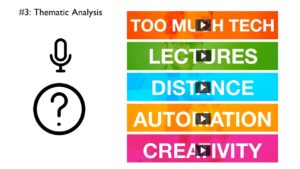Bouncing around a bit over the next few weeks/months with speaking engagements, conferences, seminars, or otherwise. All of them are in some way or another about learning futures and all touch on my research interests in one way or another. I will write longer posts providing full slidedecks and some notes, but for now I highlight three presentations and some takeaways.
#1: Gallagher, M. (2018). “No one should feel othered or alone”: Near Future Teaching and the Future of Digital Education at the University of Edinburgh. Future of Learning Conference 2018: Pedagogy, Policy and Technology in a Digital World, January 15-17, 2018. Bangalore, India.
This one is mostly exploring how the Near Future Teaching is structuring our methods for eliciting thoughts on the future of the university and how technology can accelerate or inhibit those efforts. A few of the slides below.
#2: Gallagher, M. (2018). Equity not Equality: SMS and How Designing Women into ICT4D Might Inspire Digital Education at the University of Edinburgh. Oxford University Department of Education Seminar Series, Oxford.
I am lucky enough to be invited to Oxford University for a seminar on how my past development work with Panoply Digital and at the University of Edinburgh, mostly using SMS, MMS, and some basic ICT4D, can inform future oriented design at the University of Edinburgh. Some of the (many) slides below. Essentially, the seminar will highlight three projects mostly dealing with education in development contexts and the necessity of designing women into these from the onset. The lessons learned are feeding directly into projects I work on exploring the future of digital education at the University of Edinburgh.
#3: Gallagher, M. (2018). The Mobile Campus: Imagining The Future of Distributed Education at the University of Edinburgh. Festival of Creative Learning, University of Edinburgh.
James Lamb and I, both of the Centre for Research in Digital Education, are hosting a mobile learning event as part of the Festival of Creative Learning at the University of Edinburgh. James has written an excellent post exploring the parameters of what we are trying to do so my post is really just about reiterating all of that and providing the text we are using for the event. So if you have an affiliation with the university- staff, students, alumni- join in wherever you are. We are interested in exploring the distributed university and what that might mean for how people define campus and what the future of that campus might be.
The event is designed to explore a series of provocations delivered via mobile messaging on what the future of distributed (and digital) education will be for the university. The event will be 45-60 minutes in length, and moving through select aspects of the campus. Participants will comprise both on-campus students and staff, as well as any distance education students that might wish to participate, creating essentially a distributed mobile learning activity: multiple locations, multiple group configurations, and multiple spatial dimensions.
Beyond these pedagogical and logistical explorations, the activity has a core aim: to identify the future of the University of Edinburgh as seen through a mobile and highly distributed perspective. And to do so with members of the University of Edinburgh community wherever they might be: at home, at the office, at George Square, Kings Buildings, Moray House, on any of the campuses in Edinburgh or the thousands of smaller campuses that our distance students inhabit. To quote my more intelligent colleagues, do not succumb to campus envy. We are the campus. It is with us and we are going to redefine it.
Participants will be delivered at automated intervals prompts (provocations), questions, or passages from selected texts exploring the future of disciplinary fieldwork, the future of distributed education (particularly relevant as the university attempts to broaden their digital education offerings as part of their core business strategy), and values-oriented questions as to what the university does in the future: access, equity, decolonization, compassion, identity, and so forth. A lot of ground to cover 140+ characters at a time. But we can do it. This is fieldwork that many disciplines depend on as part of their core practice. We are just tweaking it a bit for a mobile campus. The data that participants submit will be projected live in 50 George Square, remixed by Michael Gallagher and James Lamb. The sounds, images, and text that participants submit will become a part of the texture of the traditional campus, informing those at 50 George Square that there is a much broader campus at work. This broader campus will coexist with the traditional one.
The event is entirely open in that there are no preconceived boundaries (aside from the physical or imagined campus). It is about distributed collaboration, participating wherever you are and wherever you want the campus to be. We will follow a path through the campus that was guided, at least partly, by embodied disposition, or what Bourdieu describes as habitus (1977), an evolving personality structure of the individual, a composite set of schemata, sensibilities, tastes, and dispositions. In mobile learning, it is expressed as the ability, even expectation, of the individual to interact across contexts as disposition, rather than as explicitly purposeful. Individuals interact because they are disposed to, rather than always in response to pressing need or predefined purpose. As we make our way through the campus, our pace and direction will be shaped by the way that our of our own feelings, meaning schemes, intuitions and physical traits will come together with the range of meaning-making phenomena we encounter. This disposition will be surfaced with a direct provocation and activity towards this effect. I believe it to be highly experimental, although not radically so. It has been field tested in some configuration many times by the organisers.













